Welcome to our comprehensive Rottweiler training guide, where you’ll learn everything you need to know to effectively train your Rottweiler and unlock success with your pet.
Key Takeaways:
- Understanding Rottweiler behavior and temperament is essential for successful training.
- Start training early to establish a solid foundation.
- Socialization is crucial to prevent future behavioral issues.
- Crate training can be effective for potty training.
- Use positive reinforcement and operant conditioning techniques for obedience training.
Understanding Rottweiler Behavior and Temperament
Before embarking on your Rottweiler training journey, it’s essential to understand their unique behavior and temperament. Rottweilers are known for their guarding instincts and assertiveness, which can make them a challenge to train if not approached correctly. They have a strong sense of loyalty and are naturally protective of their families, making them excellent guard dogs. However, this innate instinct also means that they can be wary of strangers and potentially aggressive if not properly socialized.
Rottweilers are intelligent and eager to please, ranking high in obedience when trained with positive reinforcement and operant conditioning techniques. It’s important to provide them with consistent leadership and firm, fair training methods. They respond well to reward-based training, where they learn commands and behaviors through positive associations with treats and praise.
During the critical fear imprint stage, which occurs between 8 and 10 weeks of age, it’s crucial to expose Rottweilers to a variety of people, animals, and environments. This socialization period helps them develop into well-rounded and confident dogs. By introducing them to different stimuli during this time, you can help prevent fear-based behaviors and aggression in the future.
Understanding the behavior and temperament of Rottweilers is key to successful training. With patience, consistency, and a deep understanding of their unique traits, you can train your Rottweiler to be a well-behaved and affectionate family pet. By establishing yourself as a confident leader and utilizing positive reinforcement techniques, you can build a strong bond with your Rottweiler and ensure a harmonious relationship.

– Rottweilers have guarding instincts and assertiveness, making understanding their behavior crucial for training success.
– Starting training early is important, as Rottweilers are quick learners and rank high in obedience.
– Proper socialization during the fear imprint stage helps prevent behavioral issues in the future.
– Crate training can be effective, especially for potty training.
– Obedience training should focus on positive reinforcement and operant conditioning techniques.
– Establishing leadership and consistency in training can transform Rottweilers into well-behaved family pets.
| Key Points: | Details: |
|---|---|
| Rottweiler Behavior | Guarding instincts, assertiveness |
| Training Approach | Positive reinforcement, firm leadership |
| Socialization | During fear imprint stage (8-10 weeks) |
| Crate Training | Effective for potty training |
| Obedience Training | Positive reinforcement and operant conditioning |
| Leadership and Consistency | Vital for well-behaved family pets |
Starting Early: Rottweiler Puppy Training
Rottweiler puppy training is a vital step in ensuring your pet grows up to be a well-behaved and obedient adult. These intelligent and eager-to-please dogs are known for their quick learning abilities, making it crucial to start training from a young age. By establishing a solid foundation early on, you can shape your Rottweiler’s behavior and develop a strong bond with your furry companion.
The key to successful Rottweiler puppy training lies in positive reinforcement and consistency. Reward-based training methods, using treats and verbal praise, are highly effective in teaching your puppy basic commands and desired behaviors. By rewarding good behavior, you reinforce the positive associations and encourage them to repeat those actions. This approach helps build their confidence and trust in you as their leader.
When training your Rottweiler puppy, it is important to focus on essential commands such as “sit,” “stay,” and “come.” These commands lay the foundation for future obedience and can be taught using treat luring techniques. By holding a treat above their nose and moving it towards their tail, you can guide them into the desired position. Once they successfully perform the command, reward them with the treat and praise to reinforce the behavior.
Table: Essential Rottweiler Puppy Training Commands
| Command | Description |
|---|---|
| Sit | Teach your puppy to sit on command, which is useful for various situations, such as meal times or when greeting guests. |
| Stay | Train your puppy to stay in one place until released, ensuring their safety and preventing them from roaming off. |
| Come | Establish recall training early on so that your puppy learns to come to you when called, promoting their safety and enabling off-leash activities. |
In addition to basic commands, early socialization is crucial for Rottweiler puppies. Introduce them to various environments, people, and other animals to prevent fear or aggression issues later in life. Expose them to different sounds, sights, and experiences in a positive and controlled manner to build their confidence and ensure they grow up to be well-adjusted adults.
By investing time and effort into Rottweiler puppy training, you are setting the stage for a harmonious and fulfilling relationship with your pet. Remember to be patient, consistent, and reward their progress. Training should be a positive experience for both you and your Rottweiler, strengthening your bond and fostering a lifetime of good behavior.
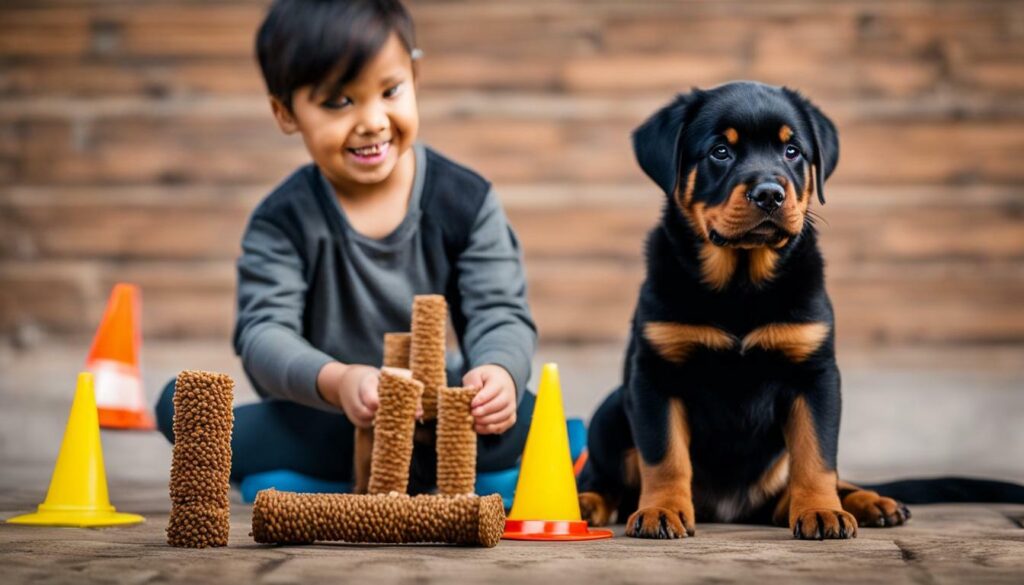
Socialization plays a crucial role in Rottweiler training, especially during the fear imprint stage when they are most receptive to new experiences. Introducing your Rottweiler puppy to various people, animals, and environments helps them develop confidence and adaptability. By exposing them early on, you can prevent fear-based aggression and ensure they grow into well-rounded adult dogs.
During the fear imprint stage, which typically occurs between 8 and 10 weeks old, Rottweilers are more likely to form lasting impressions of new stimuli. This is the ideal time to expose them to different sounds, sights, smells, and textures. Gradually introduce them to various situations, such as meeting other dogs and people, encountering different surfaces, and navigating unfamiliar environments.
To ensure a positive socialization experience, use treats and rewards to associate new encounters with positive outcomes. Reward your Rottweiler puppy for calm, confident behavior when they meet new people or experience novel situations. This helps them associate positive emotions with new experiences, making them more likely to approach future situations with confidence.
Key Tips for Socializing Your Rottweiler Puppy
- Expose your Rottweiler to a wide variety of people, including adults, children, and individuals wearing different types of clothing.
- Introduce your puppy to friendly, well-behaved dogs of different sizes, breeds, and temperaments.
- Gradually expose your Rottweiler to different environments, such as parks, busy streets, and crowded areas.
- Expose them to various sounds, such as doorbells, sirens, vacuum cleaners, and fireworks, to desensitize them to loud noises.
- Offer positive reinforcement and rewards, such as treats, praise, and playtime, for calm and confident behavior during socialization sessions.
Remember, socialization is an ongoing process that should continue throughout your Rottweiler’s life. Regular exposure to new experiences and environments will help ensure their continued comfort and adaptability in various situations.

| Socialization Benefits | Why It’s Important |
|---|---|
| Prevents fear-based aggression | Proper socialization helps prevent fear-based aggression by familiarizing Rottweilers with different stimuli, reducing their likelihood of reacting defensively. |
| Promotes confidence | Exposing Rottweilers to new experiences and positive interactions builds their confidence, making them more comfortable and adaptable in various situations. |
| Creates a well-rounded dog | A well-socialized Rottweiler is more likely to be well-behaved and friendly, making them a joy to have as part of your family and community. |
Crate Training for Rottweilers
Crate training can be an effective tool in Rottweiler obedience training, fostering discipline, and providing a safe space for your pet. Rottweilers are known for their strong guarding instincts and assertiveness, which can sometimes lead to behavioral issues if not properly channeled. By introducing crate training early on, you can establish boundaries and teach your Rottweiler valuable skills.
When crate training your Rottweiler, it’s important to make the crate a positive and comfortable space. Choose a crate that is appropriately sized for your dog, allowing them enough room to stand, turn, and lie down comfortably. Place soft bedding and a few toys in the crate to create a cozy environment.
Start by introducing your Rottweiler to the crate gradually. Encourage them to explore it by placing treats or their favorite toys inside. Gradually increase the duration of time they spend in the crate, always ensuring they have positive experiences. Use a command like “crate” or “kennel” when asking them to enter the crate, and reward them with praise and treats when they comply.
Tips for Successful Crate Training:
- Establish a consistent routine for crate time, including regular feeding and potty breaks.
- Never use the crate as a form of punishment.
- Avoid leaving your Rottweiler in the crate for extended periods; they are social animals and need regular interaction.
- Gradually increase the duration of time spent in the crate, starting with short intervals and gradually building up to longer periods.
Crate training can also aid in potty training your Rottweiler. Dogs naturally avoid soiling their sleeping area, so utilizing the crate can help teach them bladder control. Take your Rottweiler outside frequently, especially after meals and naps, and praise them when they eliminate in the appropriate spot. With consistency and positive reinforcement, your Rottweiler will learn to associate the crate with a safe and comforting space.
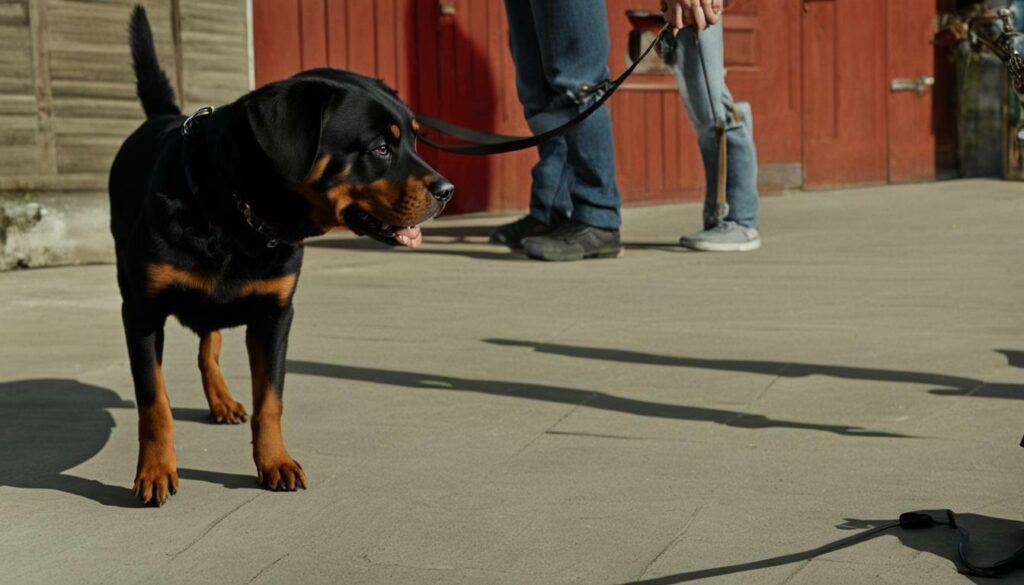
| Benefits of Crate Training for Rottweilers | Why It Works |
|---|---|
| 1. Provides a safe and secure space for your Rottweiler | The crate becomes their den, offering a sense of security and comfort. |
| 2. Helps prevent destructive behavior | When properly trained, your Rottweiler will learn acceptable chewing habits and avoid destructive behavior. |
| 3. Facilitates travel and vet visits | Your Rottweiler will be familiar and comfortable with the crate, making travel and vet visits less stressful. |
| 4. Assists in potty training | The crate teaches your Rottweiler to hold their bladder and establish a routine for going outside. |
Obedience Training Techniques for Rottweilers
Obedience training is a cornerstone of Rottweiler training, and understanding the right techniques is crucial for success. These intelligent and strong-willed dogs respond well to positive reinforcement and operant conditioning methods. By using rewards and consistent commands, you can effectively teach them important obedience skills and commands.
One effective technique is treat luring, where you use a small treat to guide your Rottweiler into desired positions or movements. For example, to teach the “heel” command, hold a treat close to your dog’s nose and walk forward. As they follow the treat, their position will naturally align with yours. Reward them with the treat and praise when they maintain the proper alignment. Repeat this exercise regularly, gradually reducing the reliance on treats as they master the command.
Pro Tip: Always use high-value treats, such as small pieces of cooked chicken or cheese, to motivate and reward your Rottweiler during training sessions. This will make the learning process more enjoyable for them and increase their eagerness to comply with your commands.
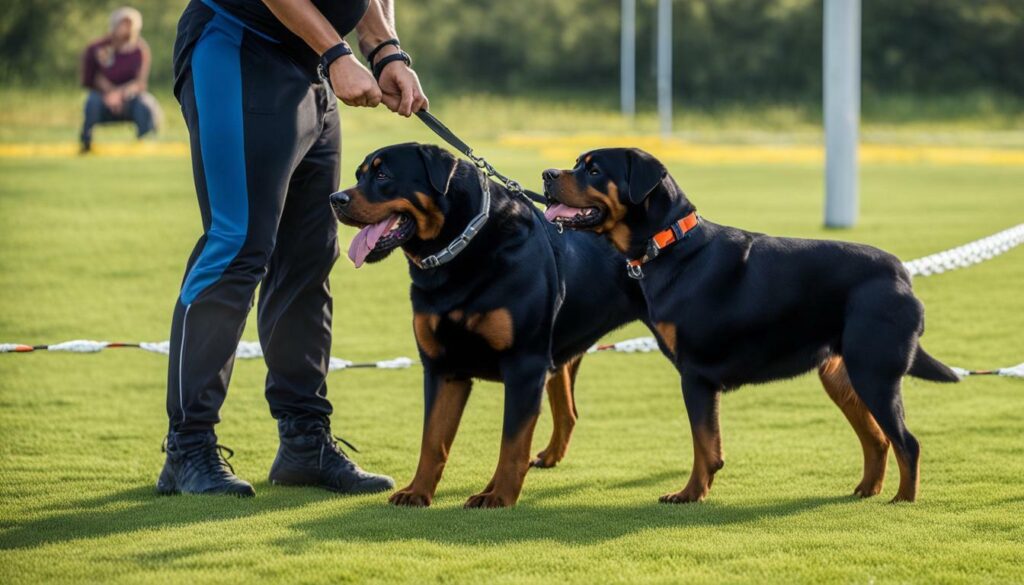
Creating a consistent schedule is key to successful Rottweiler training. By establishing a routine, you can help your dog understand what is expected of them and reinforce positive behaviors. Here’s a sample training schedule to guide you:
| Time | Activity |
|---|---|
| 7:00 AM | Morning walk or exercise session |
| 8:00 AM | Breakfast and potty break |
| 9:00 AM | Training session: Focus on obedience commands |
| 10:00 AM | Playtime and mental stimulation activities |
| 12:00 PM | Lunch and potty break |
| 1:00 PM | Training session: Address specific behavioral issues |
| 3:00 PM | Structured playtime or socialization with other dogs |
| 6:00 PM | Dinner and potty break |
| 7:00 PM | Training session: Reinforce commands and practice new skills |
| 8:00 PM | Relaxation time with toys and puzzles |
| 10:00 PM | Final potty break and bedtime |
Remember, consistency and patience are key when training Rottweilers. With the right techniques and dedication, you can develop a strong bond with your Rottweiler and nurture them into a well-behaved and obedient companion.
Leadership and Consistency in Rottweiler Training
Effective Rottweiler training requires strong leadership and consistency in your training approach. As natural-born protectors with a confident and assertive demeanor, Rottweilers respond best to owners who establish themselves as calm, authoritative leaders. By setting clear boundaries and consistently enforcing rules, you can create a stable and secure environment for your Rottweiler to thrive.
Consistency is key when it comes to Rottweiler training. Establish a routine that includes regular training sessions, exercise, and socialization opportunities. This consistency helps Rottweilers understand what is expected of them and reinforces desired behaviors. Be patient and persistent, as training a Rottweiler may take time and repetition.
Positive reinforcement is an effective training technique for Rottweilers. Use rewards such as treats, praise, and playtime to encourage desired behaviors. This approach builds trust and strengthens the bond between you and your Rottweiler. Avoid harsh punishments or physical corrections, as these methods can damage the relationship and lead to fear or aggression.
The Importance of Socialization
Socialization plays a crucial role in Rottweiler training. Introduce your Rottweiler to various people, animals, and environments from an early age to help them develop appropriate social skills and confidence. Use controlled interactions and positive experiences to ensure your Rottweiler becomes comfortable and well-mannered in different situations.
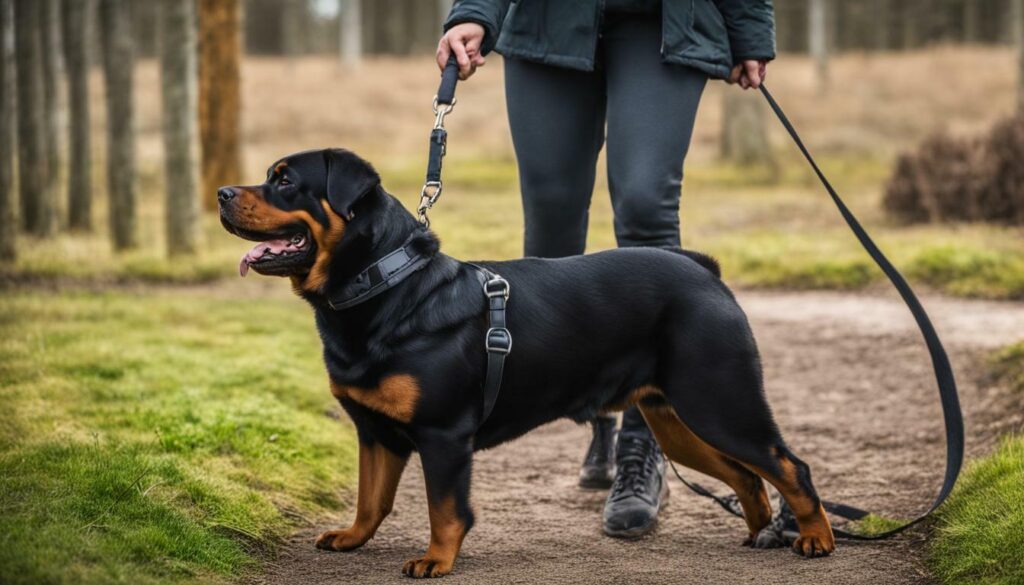
| Rottweiler Training Tips |
|---|
| Establish yourself as a calm and authoritative leader. |
| Consistently enforce rules and boundaries. |
| Use positive reinforcement, such as treats and praise. |
| Avoid harsh punishments or physical corrections. |
| Start socializing your Rottweiler early and introduce them to various people, animals, and environments. |
Transforming Rottweilers into Well-Behaved Family Pets
With the right training techniques and consistent effort, Rottweilers can become loving and well-behaved family pets. These powerful and intelligent dogs thrive in an environment that provides structure, guidance, and positive reinforcement. By understanding their behavior and temperament, starting training early, and incorporating effective techniques, you can transform your Rottweiler into a well-behaved companion.
Rottweilers are known for their guarding instincts and assertiveness. Channeling their natural energy through training and socialization is essential. Begin by establishing yourself as a confident leader, using firm yet gentle guidance. Consistency is key, as Rottweilers respond well to routines and clear expectations. Implementing positive reinforcement techniques, such as treats and praise, will motivate them and strengthen the bond between you and your pet.
Proper socialization is crucial for Rottweilers to develop good behavior. During the fear imprint stage, between 8 and 10 weeks old, expose your puppy to a variety of people, animals, and environments. Gradually increase their exposure, ensuring positive experiences and rewarding calm behavior. This will help prevent fear-based aggression and anxiety later in life.
| Rottweiler Training Tips |
|---|
| Start training early to establish a solid foundation. |
| Use positive reinforcement techniques, such as treats and praise. |
| Establish clear expectations and be consistent with your training. |
| Focus on socialization during the fear imprint stage. |
| Provide plenty of physical and mental stimulation to prevent boredom. |
In addition to obedience training, crate training can be highly beneficial for Rottweilers. It provides them with a safe and comfortable space and aids in housebreaking. Introduce the crate gradually and make it a positive experience with treats and praise. Use verbal cues and patience to teach your Rottweiler to enter and exit the crate willingly.
Remember, transforming your Rottweiler into a well-behaved family pet requires time, patience, and consistency. Celebrate their successes and provide plenty of physical and mental stimulation to prevent boredom. With proper training and a loving environment, Rottweilers can become loyal, obedient, and cherished members of your family.
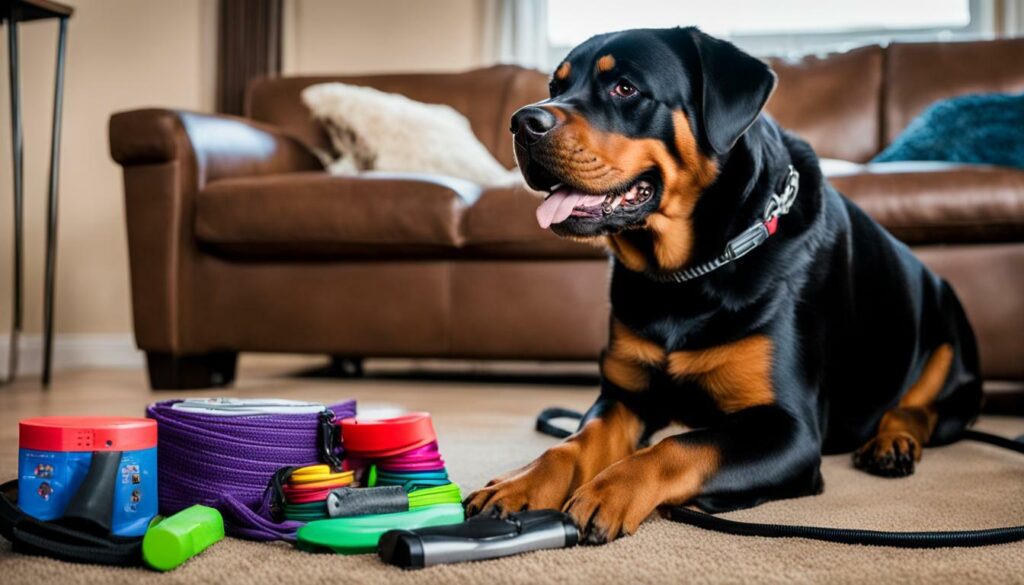
Ready to embark on your Rottweiler training journey? Start today and unlock the potential of your beloved pet. Mastering the art of comprehensive Rottweiler training requires understanding their behavior and temperament. These intelligent and energetic dogs are known for their guarding instincts and assertiveness, making it crucial to properly channel their energy.
Starting early is key when it comes to Rottweiler training. With their quick learning abilities and high obedience rankings, training during the puppy stage sets a solid foundation for their future behavior. Socialization is also essential, especially during the fear imprint stage between 8 and 10 weeks old. By exposing your Rottweiler to a variety of people, animals, and environments, you can help prevent behavioral issues in the future.
Crate training can be an effective technique for Rottweilers, particularly when it comes to potty training. By using a crate as a safe and comfortable space for your dog, you can establish a routine and teach them to hold their bladder. Additionally, obedience training should focus on positive reinforcement and operant conditioning. Using treat luring techniques, commands like “heel,” “come,” and “down” can be taught effectively.
Remember, proper leadership and consistency are essential in Rottweiler training. Establishing yourself as the pack leader and maintaining consistent training practices will contribute to their overall behavior and development. With dedication and the right techniques, you can transform your Rottweiler into a well-behaved and affectionate family pet. So why wait? Start your Rottweiler training journey today and unlock the full potential of your beloved companion.
FAQ
Q: What is the importance of understanding Rottweiler behavior and temperament?
A: Understanding Rottweiler behavior and temperament is crucial for successful training, as it helps owners effectively address their guarding instincts and assertiveness.
Q: Why is it important to start training Rottweiler puppies early?
A: Starting training early with Rottweiler puppies is essential because they learn quickly and rank high in obedience. This phase sets a solid foundation for their future behavior.
Q: How can socialization benefit Rottweiler training?
A: Socialization plays a key role in Rottweiler training, especially during the fear imprint stage from 8 to 10 weeks old. Proper socialization helps prevent behavioral issues in the future.
Q: What are the benefits of crate training for Rottweilers?
A: Crate training is effective for Rottweiler obedience training, particularly for potty training. It provides a safe and secure space while teaching them to control their bladder and bowel movements.
Q: What techniques are recommended for Rottweiler obedience training?
A: Rottweiler obedience training should focus on positive reinforcement and operant conditioning. Treat luring techniques can be used to teach commands like “heel,” “come,” and “down.”
Q: Why is leadership and consistency important in Rottweiler training?
A: Establishing proper leadership and consistent training practices with Rottweilers helps shape their behavior and development, promoting a well-behaved and balanced pet.
Q: How can training transform Rottweilers into well-behaved family pets?
A: Proper training can transform Rottweilers into well-behaved and affectionate family pets by teaching them appropriate behavior and providing them with structure and guidance.
Q: How can I start my Rottweiler training journey?
A: You can start your Rottweiler training journey today by applying the strategies and techniques discussed in this training guide. Consistency and patience are key to success.
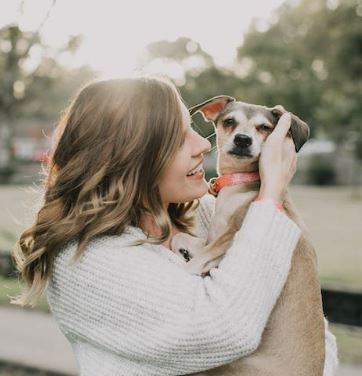
Marissa Delotta, 36, from Dayton, Ohio, is the creative force behind Roverboard.com, a beloved online destination for dog lovers. As a dedicated mom and canine enthusiast, Marissa combines her family experiences with her love for dogs to offer a platform where dog owners can exchange tips, heartwarming stories, and advice. Her website has become a vibrant community for sharing the joys of dog parenting. In her free time, Marissa enjoys exploring dog parks with her family and volunteering at local animal shelters.